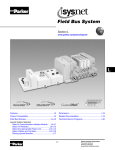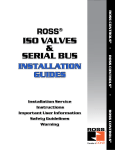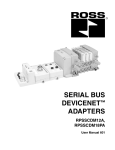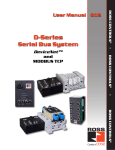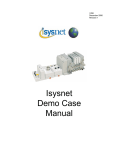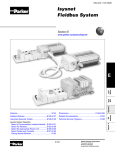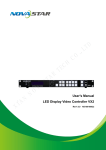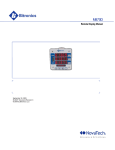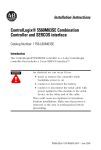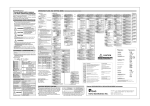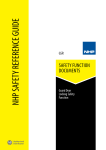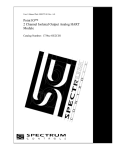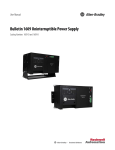Download A10312 - Ross Controls
Transcript
Installation & Service Instructions A10312 Serial Bus 32 Point Valve Driver, Series A (RPSSV32A) ISSUED: August, 2007 Supersedes: None ! WARNING To avoid unpredictable system behavior that can cause personal injury and property damage: • Disconnect electrical supply (when necessary) before installation, servicing, or conversion. • Disconnect air supply and depressurize all air lines connected to this product before installation, servicing, or conversion. • Operate within the manufacturer’s specified pressure, temperature, and other conditions listed in these instructions. • Medium must be moisture-free if ambient temperature is below freezing. • Service according to procedures listed in these instructions. • Installation, service, and conversion of these products must be performed by knowledgeable personnel who understand how pneumatic products are to be applied. • After installation, servicing, or conversion, air and electrical supplies (when necessary) should be connected and the product tested for proper function and leakage. If audible leakage is present, or the product does not operate properly, do not put into use. • Warnings and specifications on the product should not be covered by paint, etc. If masking is not possible, contact your local representative for replacement labels. Introduction Follow these instructions when installing, operating, or servicing the product. Serial Bus 32 Point Valve Driver, Series A (RPSSV32A) The sealed IP67 housing of these modules requires no enclosure. (Note that environmental requirements other than IP67 may require an additional appropriate housing.) The RPSSV32A module is shown below. The RPSSV32A valve driver module provides an interface between the serial bus system and the valve assembly. This module will always be the last module on the serial bus. It controls 32 digital outputs at 24VDC. Depending on valve selection, it can control up to 32 single solenoid valves or 16 double solenoid valves. RPSSV32A S A V32 PSS S O R Mod lt Fau Net Safety Guide For more complete information on recommended application guidelines, see the Installation Safety Guidelines section of Bulletin 600 (Form A10309) or you can download the Installation Safety Guidelines at: www.rosscontrols.com/rosslit.htm. Outputs 1- 24 Connector Outputs 25- 32 Connector ! WARNING FAILURE OR IMPROPER SELECTION OR IMPROPER USE OF THE PRODUCTS AND/OR SYSTEMS DESCRIBED HEREIN OR RELATED ITEMS CAN CAUSE DEATH, PERSONAL INJURY AND PROPERTY DAMAGE. This document and other information from ROSS CONTROLS, its subsidiaries and authorized distributors provide product and/or system options for further investigation by users having technical expertise. It is important that you analyze all aspects of your application, including consequences of any failure and review the information concerning the product or systems in the current product catalog. Due to the variety of operating conditions and applications for these products or systems, the user, through its own analysis and testing, is solely responsible for making the final selection of the products and systems and assuring that all performance, safety and warning requirements of the application are met. The products described herein, including without limitation, product features, specifications, designs, availability and pricing, are subject to change by ROSS CONTROLS and its subsidiaries at any time without notice. EXTRA COPIES OF THESE INSTRUCTIONS ARE AVAILABLE FOR INCLUSION IN EQUIPMENT / MAINTENANCE MANUALS THAT UTILIZE THESE PRODUCTS. CONTACT YOUR LOCAL REPRESENTATIVE. Serial Bus 32 Point Valve Driver, Series A (RPSSV32A) Important User Information ATTENTION Solid state equipment has operational characteristics differing from those of electromechanical equipment. Safety Guidelines for the Application, Installation and Maintenance of Solid State Controls (Form #A10325) (available online at www.rosscontrols.com/rosslit. htm), describes some important differences between solid state equipment and hard-wired electromechanical devices. Because of these differences, and also because of the wide variety of uses for solid state equipment, all persons responsible for applying this equipment must satisfy themselves that each intended application of this equipment is acceptable. In no event will ROSS CONTROLS® be responsible or liable for indirect or consequential damages to persons or property resulting from the use or application of this equipment. The examples and diagrams in this manual are included solely for illustrative purposes. Because of the many variables and requirements associated with any particular installation, ROSS CONTROLS cannot assume responsibility or liability for actual use based on the examples and diagrams. No patent liability is assumed by ROSS CONTROLS with respect to use of information, circuits, equipment, or software described in this manual. Reproduction of the contents of this manual, in whole or in part, without written permission of ROSS CONTROLS is prohibited. Throughout this manual we use notes to make you aware of safety considerations. WARNING ! Identifies information about practices or circumstances that can cause an explosion in a hazardous environment, which may lead to personal injury or death, property damage, or economic loss. IMPORTANT Identifies information that is critical for successful application and understanding of the product. ATTENTION Identifies information about practices or circumstances that can lead to personal injury or death, property damage, or economic loss. Attentions help you: • Identify a Hazard • Avoid a Hazard • Recognize the Consequence ! SHOCK HAZARD Labels may be located on or inside the equipment to alert people that dangerous voltage may be present. BURN HAZARD Labels may be located on or inside the equipment to alert people that surfaces may be dangerous temperatures. ! Environment and Enclosure This equipment is intended for use in overvoltage Category II applications (as defined in IEC publication 60664-1), at altitudes up to 2000 meters without derating. This equipment is considered Group 1, Class A industrial equipment according to IEC/CISPR Publication 11. Without appropriate precautions, there may be potential difficulties ensuring electromagnetic compatibility in other environments due to conducted as well as radiated disturbance. This equipment is supplied as “enclosed” equipment. It should not require additional system enclosure when used in locations consistent with the enclosure type ratings stated in the Specifications section of this publication. Subsequent sections of this publication may contain additional information regarding specific enclosure type ratings, beyond what this product provides, that are required to comply with certain product safety certifications. NOTE: See NEMA Standards publication 250 and IEC publication 60529, as applicable, for explanations of the degrees of protection provided by different types of enclosure. Also, see the appropriate sections in this publication, as well as the publication A10324 (“Industrial Automation Wiring and Grounding Guidelines”), for additional installation requirements pertaining to this equipment. ATTENTION ! Preventing Electrostatic Discharge This equipment is sensitive to electrostatic discharge, which can cause internal damage and affect normal operation. Follow these guidelines when you handle this equipment: •Touch a grounded object to discharge potential static. •Wear an approved grounding wrist strap. •Do not touch connectors or pins on component boards. •Do not touch circuit components inside the equipment. •If available, use a static-safe workstation. •When not in use, store the equipment in appropriate staticsafe packaging. © 2007 ROSS CONTROLS®. All Rights Reserved. Serial Bus 32 Point Valve Driver, Series A (RPSSV32A) Mount the I/O Base To mount the I/O base on a wall or panel, use the screw holes provided in the base. IMPORTANT The I/O module must be mounted on a grounded metal mounting plate or other conductive surface. *Depending on the type and number of manifolds, this dimension may vary. Consult Ross for specific information. A mounting illustration for the base with an adapter is shown below. 1.9 (47.2) 2.0 (50) 0.87 (22) 2.0 (50) 3.13 (79.4) 5.98* (151.9) Adapter 2.39 (60.7) 4.02 (102) 4.32 (109.8) 1.81 (46) Inches (mm) 3.02 (76.6) Drill and Tap for M4 Screw 5.39 (137.0) Install the 32 Point Valve Driver Drill and Tap for M6 Screw To Install the 32 Point Valve Driver, Proceed as Follows: 1.Assemble the valve driver to the manifold interface plate using four M4 screws, torqued 11 to 13 in. lbs. 2.Plug the 32 point valve driver onto the previous mounting base or communication adapter. Wire the 32 Point Valve Driver Following are wiring instructions for the 32 point valve driver. Use the appropriate harness assembly based on your manifold wiring/interconnect system. Harness Assembly Kit Numbers Series W66, Size 0 Series W66, Size 00 Series W65, Size 1 Series W65, Size 2 Series W65, Size 3 1 to 24 Outputs 25 to 32 Outputs RPS5624P RPS5632P RPS4024P RPS4032P Plug the 2X15 connector into the valve driver module for 1-24 outputs. If you have more than 24 outputs, plug the 2X5 connector into the valve driver module for 25-32 outputs. Outputs 1- 24 Connector Outputs 25- 32 Connector Plug the 2X10 and 1X10 connectors into the interconnect board in the valve manifold. EDS File Requirements The EDS file is available online at www.rosscontrols.com/rosslit.htm ATTENTION ! Make sure all four screws are securely tightened to properly seal the connections against leaks and maintain IP67 requirements. www.rosscontrols.com Serial Bus 32 Point Valve Driver, Series A (RPSSV32A) Communicate With Your Module I/O messages are sent to (consumed) and received from (produced) the I/O modules. These messages are mapped into the processor’s memory. The 32 point valve driver produces 1 byte of input data (scanner Rx - status), and consumes 1 byte of I/O data (scanner Tx). Default Data Map for the 32 Point Valve Driver RPSSV32A Message Size: 1 Byte Byte Bit 7 Bit 6 Bit 5 Bit 4 Bit 3 Bit 2 Bit 1 Bit 0 Produce 0 OutputOutput OutputOutput OutputOutputOutput Output 7 6 5 4 3 2 1 0 Produce 1 OutputOutput OutputOutput OutputOutputOutput Output 15 14 13 12 11 10 9 8 Produce 2 OutputOutput OutputOutput OutputOutputOutput Output 23 22 21 20 19 18 17 16 Produce 3 OutputOutput OutputOutput OutputOutputOutput Output 31 30 29 28 27 26 25 24 Produce 4 Fault Fault Fault Fault Fault Fault Fault Fault 28-31 24-27 20-23 16-19 12-15 8-11 4-7 0-3 Setup the 32 Point Valve Driver in ControlNet Step 1: Load 32 Point Valve Driver EDS file to RSLinx •Download EDS file from www.rosscontrols.com/rosslit.htm •On your computer, follow Start➔Rockwell Software➔RSLinx Tools➔EDS Hardware Installation Tool to load the EDS file to RSLinx Step 2: Add Controller and Communication Module to the RSLogix 5000 I/O Configuration •Add a controller and a communication module (Serial Bus RPSSCCNA or Rockwell 1738-ACNR) to I/O configuration. Reference pages 4-1 through 4-7 of Rockwell publication 1734-UM008 (follow www.rockwell.com➔Support➔Support Overview➔Online manuals and literature➔I/O➔1734 POINT and 1734D POINT Block I/O and find POINT I/O ControlNet Adapter User Manual) for a similar setup procedure. Step 3: Add 32 Point Valve Driver to RSLogix 5000 I/O Configuration. If your RSLogic 5000 is Version 15.X or greater: •Highlight the RPSSCCNA under I/O configuration, right click and select New Module. •Choose the RPSSV32A module from the list of Parker modules. Consume 0 OutputOutput OutputOutput OutputOutputOutput Output 7 6 5 4 3 2 1 0 Consume 1 OutputOutput OutputOutput OutputOutputOutput Output 15 14 13 12 11 10 9 8 Consume 2 OutputOutput OutputOutput OutputOutputOutput Output 23 22 21 20 19 18 17 16 Consume 3 OutputOutput OutputOutput OutputOutputOutput Output 31 30 29 28 27 26 25 24 •Enter a name (optional) and click OK. Setup the 32 Point Valve Driver in DeviceNet Step 1: Load 32 Point Valve Driver EDS file to RSLinx •Download EDS file from www.rosscontrols.com/rosslit.htm •On your computer, follow Start➔Rockwell Software➔RSLinx Tools➔EDS Hardware Installation Tool to load the EDS file to RSLinx Step 2: Configure the DeviceNet Scanner Subnet •Reference Chapter 4 of the Serial Bus DeviceNet Adapters User Manual Bulletin 601 (Form #A10311) for detailed information. Make sure to add RPSSV32A to the DeviceNet Adapter’s scanlist. Step 3: Add the Serial Bus DeviceNet Adapter to the DeviceNet Scanner’s Scanlist •Reference Chapter 5 of the Serial Bus DeviceNet Adapters User Manual Bulletin 601 (Form #A10311) for detailed information. Step 4: Use 32 Point Valve Driver in RSLogix 5000 •Access RPSSV32A data via DeviceNet Scanner in the ladder logic program. Notice that the 32 Point Valve Drive Module is now under I/O Configuration. © 2007 ROSS CONTROLS®. All Rights Reserved. Serial Bus 32 Point Valve Driver, Series A (RPSSV32A) If your RSLogic 5000 is Version 13.X: •Highlight the 1738-ACNR under I/O configuration, right click and select New Module. •Choose the Generic 1738 module from the list of Allen-Bradley modules. Setup the 32 Point Valve Driver in EtherNet/IP Step 1: Load 32 Point Valve Driver EDS file to RSLinx •Download EDS file from www.rosscontrols.com/rosslit.htm •On your computer, follow Start➔Rockwell Software➔RSLinx Tools➔EDS Hardware Installation Tool to load the EDS file to RSLinx Step 2: Set IP Address for EtherNet/IP Scanner and Adapter •Set IP address using Rockwell BootP/DHCP utility for EtherNet/IP scanner and PSSCENA or 1738-AENT adapter. Reference pages 3-7 through 3-10 of Rockwell publication 1734-UM011 (follow www.rockwell.com➔Support➔Support Overview➔Online manuals and literature➔I/O➔1734 POINT and 1734D POINT Block I/O and find POINT I/O Ethernet Adapter User Manual) for similar information. Step 3: Add EtherNet/IP Scanner and Adapter to RSLogix 5000 I/O configuration. •Add EtherNet/IP scanner and PSSCENA or 1738-AENT adapter to I/O configuration. Reference pages 4-4 to 4-8 of Rockwell publication 1734-UM011 for similar information. •Enter a name (optional), an appropriate slot number and the connection parameters as shown in this screen capture. Step 4: Add 32 Point Valve Driver to RSLogix 5000 I/O Configuration. If your RSLogic 5000 is Version 15.X or greater: •Highlight the PSSCENA under I/O configuration, right click and select New Module. •Choose the RPSSV32A module from the list of Ross modules. •Choose Next to set RPI. •Choose Finish. Notice that the 32 Point Valve Driver Module is now under the I/O configuration. Step 4: Download the Program to the Controller and Configure the RPSSCCNA or 1738-ACNR Adapter. •Reference pages 4-11 through 4-15 of Rockwell publication 1734UM008 for similar setup procedure. •Enter a name (optional) and click OK. Step 5: Schedule I/O Module Connections •Reference pages 4-15 through 4-19 of Rockwell publication 1734UM008 for similar setup procedure. Step 6: Access Module Data via the RPSSCCNA or 1738-ACNR Adapter. •Make sure the 32 outputs of RPSSV32A appear in Controller Tags. Use the information in the ladder logic program to access module data. •Reference pages 4-19 through 4-22 of Rockwell publication 1734UM008 for similar information. Notice that the 32 Point Valve Drive Module is now under I/O Configuration. www.rosscontrols.com Serial Bus 32 Point Valve Driver, Series A (RPSSV32A) If your RSLogic 5000 is Version 13.X: •Highlight the 1738-AENT under I/O configuration, right click and select New Module. •Choose the Generic 1738 module from the list of Allen-Bradley modules. Setup the 32 Point Valve Driver in Profibus Step 1: Configure Valve Driver Module in SST Profibus Configuration Utility Note: SST-PFB-CLX is used here for example. For different Profibus scanners, refer to appropriate documentation for setup information. •Download GSD file from www.rosscontrols.com/rosslit.htm •In SST Profibus Configuration Utility, follow Library➔Add GSD to load the GSD file to SST Profibus. •In SST Profibus Configuration Utility, follow Browse➔Search for devices to load the GSD file to SST Profibus •Right click on the found device, follow GSD files and click on appropriate GSD for RPSSV32A. •Add RPSSV32A as slave to SST-PFB-CLX master. •Detailed information can be found in the SST-PFB-CLX User Guide (Ver. 1.4 715-0022), which is available on www.woodhead.com. Step 2: Add SST Profibus Scanner in RSLogix 5000 I/O Configuration •Add SST-PFB-CLX scanner I/O configuration. Reference pages 36 to 39 of the SST-PFB-CLX User Guide, for detailed information. •Notice that the SST-PFB-CLX scanner is now under the I/O configuration. •Enter a name (optional), an appropriate slot number and the connection parameters as shown in this screen capture. Step 3: Access Module Data via the SST-PFB-CLX Scanner and Create Ladder Program. •Reference Chapter 7 of the SST-PFB-CLX User Guide for addressing information. •Choose Next to set RPI. •Choose Finish. Notice that the 32 Point Valve Driver Module is now under the I/O configuration. Step 5: Access Module Data via the RPSSCENA or 1738-AENT Adapter and Create Ladder Program. •Make sure the 32 outputs of RPSSV32A appear in Controller Tags. Use the information in the ladder logic program to access module data. •Reference pages 4-13 through 4-14 of Rockwell publication 1734UM011 for similar information. Step 6: Download the Program to the Controller •Reference pages 4-13 through 4-14 of Rockwell publication 1734UM011 for similar information. © 2007 ROSS CONTROLS®. All Rights Reserved. Serial Bus 32 Point Valve Driver, Series A (RPSSV32A) Troubleshoot With the Indicators RPSSV32A ROSS RPSSV32A Module Status Indicator Mod Net Fault Network Status Indicator Output Fault Status Indicator Indication Probable Cause Module Status Off No power applied to device Green Device operating normally Flashing Green Device needs commissioning due to missing, incomplete, or incorrect configuration Flashing Red Recoverable fault Red Unrecoverable fault - may require device replacement Flashing Red/Green Device is in self-test Indication Probable Cause Network Status Off Device is not on line: - Device has not completed dup_MAC-id test. - Device not powered - check module status indicator. Flashing Green Device is on line but has no connections in the established state. Green Device is on line and has connections in the established state. Flashing Red One or more I/O connections in timed-out state. Red Critical link failure - failed communication device. Device detected error that prevents it from communicating on the network. Flashing Red/Green Communication faulted device - the device has detected a network access error and is in communication faulted state. Device has received and accepted an Identity Communication Faulted Request - long protocol message. Indication Probable Cause Output Fault Status Off Outputs operating normally Red Over current, short circuit or over temperature detected on one or more outputs. (On-State only) www.rosscontrols.com Serial Bus 32 Point Valve Driver, Series A (RPSSV32A) Specifications – Following are specifications for the 32 point valve driver. 32 Point Valve Driver Outputs per Module 32, sourcing Voltage Drop, On-State Output, Maximum 0.2VDC Voltage, Off-State Output, Maximum 28.8VDC Voltage, On-State Output, Maximum 28.8VDC Minimum 10VDC Nominal 24VDC Output Current Rating 200 mA per channel, not to exceed 6.0 A per module Output Surge Current, Maximum 0.5 A for 10 ms, repeatable every 3 seconds Current Leakage, Off-State Output, Maximum 0.1 mA Current, On-State Output Minimum 200 mA per channel Output Delay Time OFF to ON, Maximum1 0.1 ms Output Delay Time, ON to OFF, Maximum1 0.1 ms External DC Power Supply Voltage Range 10 to 28.8VDC External DC Power Supply Voltage Nominal 24VDC General Specifications LED Indicators 1 output status 1 green/red network status, logic side 1 green/red module status, logic side PointBus Current, Maximum 75 mA @ 5VDC Operating Temperature IEC 60068-2-1 (Test Ad, Operating Cold), IEC 60068-2-2 (Test Bd, Operating Dry Heat), IEC 60068-2-14 (Test Nb, Operating Thermal Shock): -20 to 60°C (-4 to 140°F) Storage Temperature IEC 60068-2-1 (Test Ab, Un-packaged Non-operating Cold), IEC 60068-2-2 (Test Bb, Un-packaged Non-operating Dry Heat), -40 to 85°C (-40 to 185°F) Relative Humidity IEC 60068-2-30 (Test Db, Un-packaged Non-operating Damp Heat): 5 to 95% non-condensing Shock IEC60068-2-27 (Test Ea, Unpackaged Shock): Operating 30g Non-operating 50g Vibration IEC60068-2-6 (Test Fc, Operating): 5g @ 10 to 500Hz ESD Immunity IEC 61000-4-2: 6kV contact discharges 8kV air discharges Radiated RF Immunity IEC 61000-4-3: 10V/m with 1kHz sine-wave 80%AM from 30MHz to 2000MHz 10V/m with 200Hz 50% Pulse 100%AM at 900Mhz 10V/m with 200Hz 50% Pulse 100%AM at 1890Mhz EFT/B Immunity IEC 61000-4-4: ±3kV at 5kHz on signal ports Surge Transient Immunity IEC 61000-4-5: ±1kV line-line(DM) and ±2kV line-earth(CM) on signal ports Conducted RF Immunity IEC 61000-4-6: 10Vrms with 1kHz sine-wave 80%AM from 150kHz to 80MHz Emissions CSPR 11: Group 1, Class A Enclosure Type Rating Meets IP65/66/67 (when marked) Mounting Base Screw Torque #8 screw, 7.5 in. lbs. in Aluminum, 16 in. lbs. in Steel Wiring Category2 1 - on signal ports Certifications: c-UL-us UL Listed Industrial Control Equipment, (when product is marked) certified for US and Canada CE European Union 89/336/EEC EMC Directive, compliant with: EN 61000-6-4; Industrial Emissions EN 50082-2; Industrial Immunity EN 61326; Meas./Control/Lab., Industrial Requirements EN 61000-6-2; Industrial Immunity C- Tick Australian Radiocommunications Act, compliant with: AS/NZS CISPR 11; Industrial Emissions 1. OFF to ON or ON to OFF delay is time from a valid output “on” or “off” signal to output energization or de-energization. 2. Use this Conductor Category information for planning conductor routing. Refer to Publication A10324, “Industrial Automation Wiring and Grounding Guidelines”. Printed in U.S.A -0807 © Copyright 2007, ROSS CONTROLS®. All Rights Reserved. Form A10312








